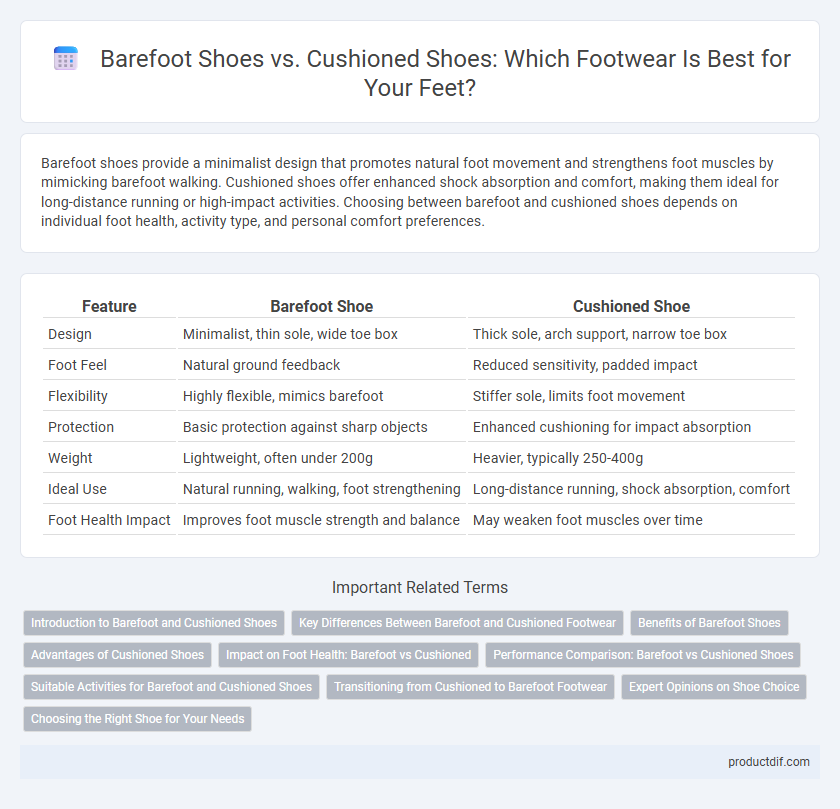Barefoot shoes provide a minimalist design that promotes natural foot movement and strengthens foot muscles by mimicking barefoot walking. Cushioned shoes offer enhanced shock absorption and comfort, making them ideal for long-distance running or high-impact activities. Choosing between barefoot and cushioned shoes depends on individual foot health, activity type, and personal comfort preferences.
Table of Comparison
| Feature | Barefoot Shoe | Cushioned Shoe |
|---|---|---|
| Design | Minimalist, thin sole, wide toe box | Thick sole, arch support, narrow toe box |
| Foot Feel | Natural ground feedback | Reduced sensitivity, padded impact |
| Flexibility | Highly flexible, mimics barefoot | Stiffer sole, limits foot movement |
| Protection | Basic protection against sharp objects | Enhanced cushioning for impact absorption |
| Weight | Lightweight, often under 200g | Heavier, typically 250-400g |
| Ideal Use | Natural running, walking, foot strengthening | Long-distance running, shock absorption, comfort |
| Foot Health Impact | Improves foot muscle strength and balance | May weaken foot muscles over time |
Introduction to Barefoot and Cushioned Shoes
Barefoot shoes mimic natural foot movement by offering minimal cushioning and promoting ground feel, enhancing proprioception and strengthening foot muscles. Cushioned shoes provide substantial padding and arch support, designed to absorb impact and enhance comfort during prolonged activities. Understanding these distinctions helps in selecting footwear that aligns with individual biomechanics and activity requirements.
Key Differences Between Barefoot and Cushioned Footwear
Barefoot shoes feature minimal cushioning and a thin sole designed to mimic natural foot movement, promoting improved balance and sensory feedback. Cushioned shoes incorporate thick, shock-absorbing midsoles that reduce impact on joints and provide enhanced comfort during prolonged wear or high-impact activities. The primary differences include sole thickness, flexibility, and support level, with barefoot shoes emphasizing foot strength and natural gait, while cushioned shoes prioritize protection and comfort.
Benefits of Barefoot Shoes
Barefoot shoes promote natural foot mechanics by allowing unrestricted toe movement and ground feel, enhancing balance and proprioception. They encourage stronger foot muscles and improved posture by mimicking barefoot walking, which reduces the risk of common foot injuries. This minimalistic design also supports better joint alignment and can alleviate chronic foot pain often associated with cushioned, over-supported footwear.
Advantages of Cushioned Shoes
Cushioned shoes provide enhanced shock absorption, reducing impact on joints during high-impact activities like running and jumping. They offer superior comfort and support for individuals with foot conditions such as plantar fasciitis or flat feet, promoting better alignment and reducing fatigue. The added padding also enhances stability on uneven surfaces, minimizing the risk of injury.
Impact on Foot Health: Barefoot vs Cushioned
Barefoot shoes promote natural foot mechanics by allowing toes to splay and encouraging a forefoot or midfoot strike, which can enhance muscle strength and proprioception. Cushioned shoes provide shock absorption that reduces impact forces on joints, potentially lowering injury risk for high-impact activities. However, excessive cushioning may weaken foot muscles over time and alter gait patterns, leading to imbalances and decreased intrinsic foot stability.
Performance Comparison: Barefoot vs Cushioned Shoes
Barefoot shoes promote natural foot mechanics by allowing greater ground feedback, enhancing balance and proprioception during running or walking. Cushioned shoes provide shock absorption and impact protection, reducing strain on joints and muscles and potentially improving comfort over long distances. Performance outcomes vary with activity type, foot anatomy, and running style, making individual preference crucial in shoe selection.
Suitable Activities for Barefoot and Cushioned Shoes
Barefoot shoes are ideal for activities that emphasize natural foot movement and proprioception, such as yoga, pilates, and light trail running, promoting foot muscle strength and balance. Cushioned shoes provide superior shock absorption and support, making them suitable for high-impact activities like long-distance running, hiking, and sports requiring rapid lateral movements. Choosing between barefoot and cushioned footwear depends on the intensity of the activity and the level of support needed to prevent injury.
Transitioning from Cushioned to Barefoot Footwear
Transitioning from cushioned shoes to barefoot footwear requires gradual adaptation to strengthen foot muscles and improve natural gait mechanics. Experts recommend starting with short wear times and low-impact activities to prevent injury while enhancing proprioception and foot stability. Proper progression supports healthier foot biomechanics, reduces dependency on thick soles, and promotes overall foot health.
Expert Opinions on Shoe Choice
Experts emphasize that barefoot shoes promote natural foot motion and strengthen foot muscles, reducing the risk of common injuries associated with over-cushioning. Cushioned shoes, favored in high-impact sports, provide superior shock absorption and comfort, benefiting runners with joint issues or flat feet. The ideal choice depends on individual biomechanics, activity type, and long-term foot health goals, with many specialists recommending a gradual transition when switching between these styles.
Choosing the Right Shoe for Your Needs
Selecting between barefoot shoes and cushioned shoes depends on individual foot biomechanics, activity type, and injury history. Barefoot shoes promote natural foot movement and strengthen foot muscles by minimizing padding, ideal for those seeking increased proprioception and foot flexibility. Cushioned shoes provide enhanced shock absorption and support, beneficial for high-impact activities or individuals requiring extra protection and comfort.
Barefoot Shoe vs Cushioned Shoe Infographic

 productdif.com
productdif.com